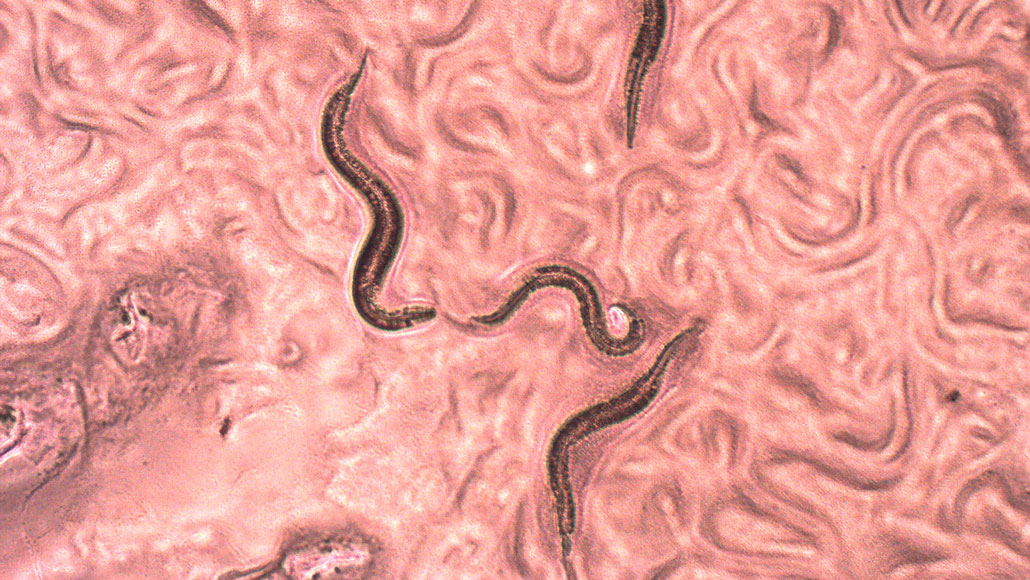
Named after Mephistopheles, a devil in Faustian legend, devil worms (Halicephalobus mephisto) live in hellish conditions up to 1.3 kilometers underground.
John Bracht and Megan Guerin
You might expect a “devil worm” to have fiery eyes and a forked tail — or horns, at the very least. But under the microscope, Halicephalobus mephisto looks nothing like its nickname. Measuring a scant half of a millimeter, it’s a little squiggle of a critter.
“There’s nothing particularly menacing about them,” says John Bracht, a molecular biologist at American University in Washington, D.C., and proud owner of the only live devil worms in a U.S. lab. Instead, the worm, a kind of nematode, earned that title because it somehow manages to live in hellish conditions, he says.
First described in 2011, H. mephisto is one of the deepest-living land animals found to date. The only live one ever caught in the wild was filtered out of water from an aquifer 1.3 kilometers underground in a South African gold mine (SN: 6/1/11). At that depth, devil worms must cope with low oxygen, high methane levels and temperatures around 37° Celsius.
The captured worm laid eight eggs. Now, thanks to that one worm’s descendants, scientists have some genetic clues to how the nematodes tolerate these conditions.
The nematodes have duplications of two genes involved in heat shock and cell survival decisions, Bracht and his team report November 21 in Nature Communications. Picking up those extra copies over time likely helped the devil worms cope with extreme conditions and move deeper underground, Bracht says.
The researchers found that H. mephisto has about 112 copies of the gene that makes Hsp70 proteins, which refold damaged proteins that have unraveled due to heat stress. That’s a big leap from the devil worm’s closest relative that has had its genetic instruction book, or genome, analyzed already — a nematode that has 35 copies of the Hsp70 gene. Heat stress tests in the lab exposing the devil worms to temperatures from 38° to 40° Celsius show that these genes ramp up to make more Hsp70 proteins when the heat is on. That suggests that these proteins somehow help the devil worms take the heat.
The Hsp70 protein “likely is one avenue to prevent damage or clean damage up,” says Jesper Sørensen, an evolutionary biologist at Aarhus University in Denmark who was not involved in the work.
But further research is needed to directly link an expansion of Hsp70 genes to an adaptation that helps the worms live underground, says Mark Blaxter, a genome biologist at the Wellcome Sanger Institute in Hinxton, England, who was not involved in the work. So far, it’s “not proven that these changes help survival,” he says.
The devil worms also have extra copies of AIG1, a gene that controls whether a cell lives or dies. A fungus that associates with plant roots might have transferred this gene to devil worms far back in the nematode’s ancestry, the researchers say. Now, devil worms have about 63 copies of AIG1. (The archetype of nematodes, Caenorhabditis elegans, has only one gene that looks somewhat similar.) In heat stress tests with the devil worms, the productivity of these genes didn’t change with temperature. Instead, extra copies of the AIG1 gene might help the worms deal with some other stress in their environment, Bracht says.
Another creature, the Pacific oyster (Crassostrea gigas), also has extra Hsp70 and AIG1 genes, Bracht and colleagues report in the December Journal of Molecular Evolution. Oysters are exposed to extreme fluctuations in temperature as the tide ebbs and flows. Because the same genetic pattern is present in two animals far apart on the tree of life, it’s likely that duplication of both the Hsp70 and AIG1 genes is a general strategy for animals to adapt to extreme environments, Bracht says.





